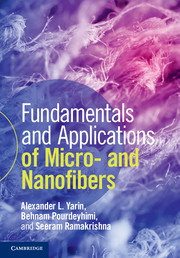Book contents
- Frontmatter
- Contents
- Preface
- 1 Introduction
- 2 Polymer physics and rheology
- 3 General quasi-one-dimensional equations of dynamics of free liquid jets, capillary and bending instability
- 4 Melt- and solution blowing
- 5 Electrospinning of micro- and nanofibers
- 6 Additional methods and materials used to form micro- and nanofibers
- 7 Tensile properties of micro- and nanofibers
- 8 Post-processing
- 9 Applications of micro- and nanofibers
- 10 Military applications of micro- and nanofibers
- 11 Applications of micro- and nanofibers, and micro- and nanoparticles: healthcare, nutrition, drug delivery and personal care
- Subject Index
- References
5 - Electrospinning of micro- and nanofibers
Published online by Cambridge University Press: 05 June 2014
- Frontmatter
- Contents
- Preface
- 1 Introduction
- 2 Polymer physics and rheology
- 3 General quasi-one-dimensional equations of dynamics of free liquid jets, capillary and bending instability
- 4 Melt- and solution blowing
- 5 Electrospinning of micro- and nanofibers
- 6 Additional methods and materials used to form micro- and nanofibers
- 7 Tensile properties of micro- and nanofibers
- 8 Post-processing
- 9 Applications of micro- and nanofibers
- 10 Military applications of micro- and nanofibers
- 11 Applications of micro- and nanofibers, and micro- and nanoparticles: healthcare, nutrition, drug delivery and personal care
- Subject Index
- References
Summary
This chapter deals with the mechanisms and electrohydrodynamic modeling of the physical processes resulting in electrospinning of nanofibers with cross-sectional diameters approximately in the range 100 nm to 1 µm. These involve the physical nature of fluids used in electrospinning, leaky dielectrics, discussed in Section 5.2, and the formation of the precursor of electrospun jets, the Taylor cone, described in Section 5.3. Polymer jets in electrospinning possess an initial straight section, which is discussed in Section 5.4. Experimental observations of the key element of the electrospinning process, the electrically driven bending instability, which is similar to the aerodynamically driven jet bending of Chapters 3 and 4, are covered in Section 5.5. Section 5.6 describes the theory of the bending instability in electrospinning. Multiple jet interaction in electrospinning and needleless electrospinning are discussed in Section 5.7. Co-electrospinning and emulsion electrospinning of core–shell fibers (Section 5.8) are based on similar physical principles to electrospinning of monolithic nanofibers. The electrostatic field-assisted assembly techniques developed with the aim of positioning and aligning individual nanofibers in arrays and ropes are discussed in Section 5.9. Melt electrospinning of polymer fibers is briefly outlined in Section 5.10.
Electrospinning of polymer solutions
Electrospinning of polymer solutions, liquid crystals, suspensions of solid particles and emulsions employs an electric field of the strength about 1 kV cm−1. The first US patent on electrospinning was issued to Formhals (1934), but interest in this process was dormant until electrified jets of polymer solutions and melts were investigated as routes to the manufacture of polymer nanofibers (Baumgarten 1971, Larrondo and Manley 1981a–c, Doshi and Reneker 1995, Reneker and Chun 1996). In electrospinning, the electric force results in an electrically charged jet flowing out from a pendant or sessile droplet (see Figure 5.1). After the jet flows away from the droplet in a nearly straight line, it bends into a complex path and other changes in shape occur, during which electrical forces stretch and thin it by very large ratios, quite similar to the effects of the aerodynamic forces in melt- and solution blowing discussed in Chapter 4. After the solvent evaporates, solidified nanofibers are left.
Information
- Type
- Chapter
- Information
- Fundamentals and Applications of Micro- and Nanofibers , pp. 179 - 261Publisher: Cambridge University PressPrint publication year: 2014
References
Accessibility standard: Unknown
Why this information is here
This section outlines the accessibility features of this content - including support for screen readers, full keyboard navigation and high-contrast display options. This may not be relevant for you.Accessibility Information
- 2
- Cited by
